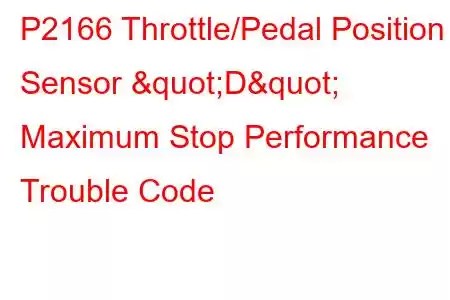P2166 Throttle/Pedal Position Sensor D Maximum Stop Performance
OBD-II Trouble Code Technical Description
Throttle/Pedal Position Sensor D Maximum Stop Performance
What does that mean?
This is a generic powertrain diagnostic trouble code (DTC) and typically applies to OBD-II vehicles. That may include but is not limited to vehicles from Ford (e.g. F-150), Chevrolet, Dodge / Ram, Jeep, Chrysler, Kia, Toyota, VW, Ferrari, etc. Although generic, the exact repair steps may vary depending on year, make, model and powertrain configuration.
A stored code P2166 means the powertrain control module (PCM) has detected a malfunction in a the "D" throttle position sensor (TPS) or a particular pedal position sensor (PPS).
The designation "D" refers to a particular sensor or part of a circuit/sensor. Consult a reliable vehicle information source for particulars pertaining to the vehicle in question. This code is only used in vehicles that are equipped with drive by wire (DBW) systems and is related to maximum stop or wide open throttle performance.
The PCM controls the DBW system using a throttle actuator motor, multiple pedal position sensors (sometimes referred to as accelerator pedal position sensors), and several throttle position sensors. The sensors are typically supplied with a 5-volts reference, a ground, and at least one signal wire.
Generally speaking, TPS/PPS sensors are of the potentiometer type. A mechanical extension, on the accelerator pedal or the throttle plate shaft, actuates the contacts of the sensor. Sensor resistance changes, as the contacts are moved across the sensor circuit board, causing variations in circuit resistance and signal input voltage to the PCM.
If the PCM detects a maximum stop/wide open throttle position sensor voltage signal (from the sensor designated D) that does not reflect the programmed parameter, a code P2166 will be stored and a malfunction indicator lamp (MIL) may be illuminated. When this code is stored, the PCM will usually enter limp in mode. Engine acceleration could be severely limited (if not totally disabled) in this mode.
A throttle position sensor (TPS):
What is the severity of this DTC?
A P2166 should be considered severe because it can result in the vehicle being undriveable.
What are some of the symptoms of the code?
Symptoms of a P2166 trouble code may include:
Lack of throttle response Limited or no acceleration Engine stall when allowed to idle Hesitation when accelerating Cruise control inoperativeWhat are some of the common causes of the code?
Causes for this P2166 throttle/pedal position sensor code may include:
Defective TPS or PPS Open or shorted circuits between the TPS, PPS, and the PCM Corroded electrical connectors Faulty DBW actuator motorWhat are some P2166 troubleshooting steps?
Check your vehicle information source for technical service bulletins (TSB) which parallel the make, model, and engine size of the vehicle in question. The symptoms and codes stored must also match. If you find a matching TSB, it will aid you dramatically in your diagnosis.
My diagnosis for a code P2166 would typically begin with a visual inspection of all system related wiring and connectors. I would also check the throttle plate for signs of carbon buildup or damage. Clean carbon from the throttle body according to manufacturer’s recommendations and repair or replace defective wiring or components as required, then retest the DBW system.
You will need a diagnostic scanner, a digital volt/ohmmeter (DVOM), and a reliable vehicle information source to accurately diagnose this code.
Next, connect the scanner to the vehicle diagnostic port and retrieve all stored trouble codes. Write them down just in case you need the information later in your diagnosis. Keep any related freeze frame da
Read: 25


